For quite some time, Flexera has put out a State of the Cloud report, and I’ve enjoyed checking out the report annually to see what’s changing. Recently, Hashicorp released the results of their first-ever State of Cloud Strategy survey, which is a great addition to the field. There are a ton of great data points in these reports, too many to comment on.
In this blog, I’ll pick a few take-aways that I found particularly interesting, as well as some perspective on the state of the cloud in 2022 in response to these reports.
Welcome to the Age of Multi-Cloud (and Beyond)
That’s actually the title of the Hashicorp report, and they present some pretty compelling data to backup their contention that:
“a common multi-cloud operating model has become the de facto standard for IT organizations of all shapes and sizes to deliver on digital transformation. IT organizations are investing significant resources in multi-cloud deployments, and those investments are already paying off. At the same time, however, companies are still dealing with a variety of multi-cloud challenges and dependencies.”
The stats from the survey back this up. 76% of all surveyed organizations said they have already deployed multi-cloud architectures, and it is estimated in two years 86% will be. For larger organizations (over 5K employees) the numbers are even more stark–90% of them are already multi-cloud.
The Flexera report also majors on multi-cloud adoption, indicating that 92% of respondents have a multi-cloud strategy. Interestingly, Flexera’s study delved a bit deeper into various cloud combinations used in enterprises with hybrid strategies. 76% of respondents said they’re using multiple public clouds, while 56% use more than one private cloud.
And just to affirm that multi-cloud isn’t an experiment, the Hashicorp survey asked if multi-cloud is helping organizations achieve business goals, with a majority of respondents saying yes, as seen below.
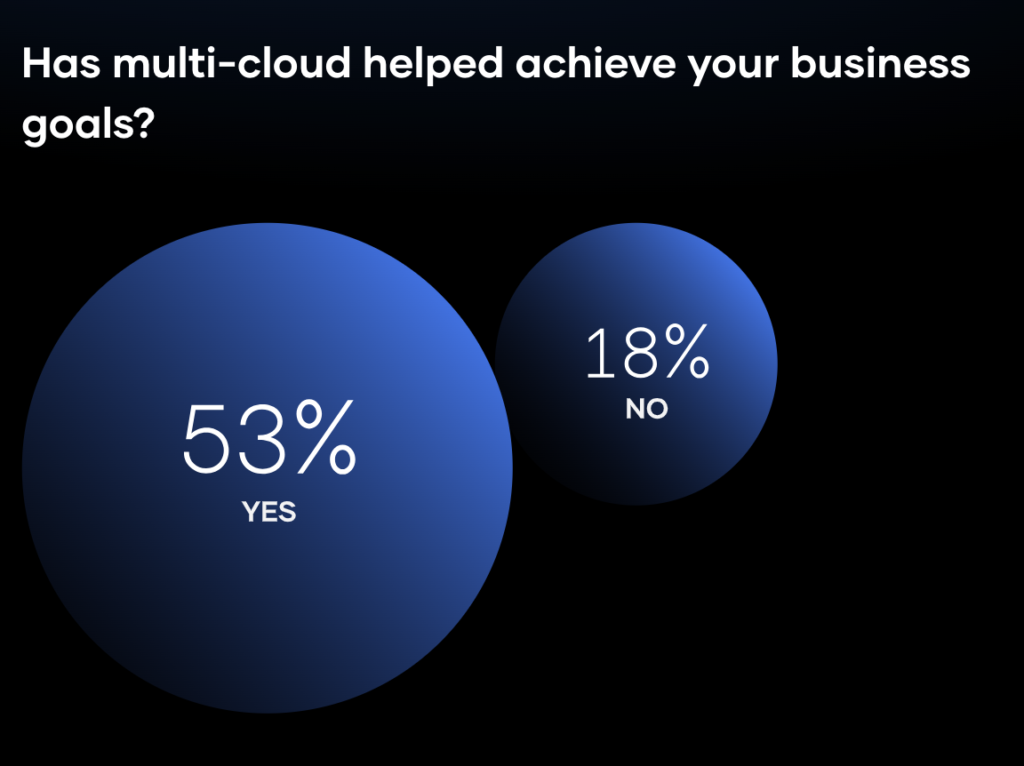
Perspective: Multi-Cloud is Expanding in Scope
But what does multi-cloud really mean? The simple version is enterprises are using more than one hyperscale public cloud provider, which is a realistic definition. However, I think the reality is it’s gone well beyond that.
We all know SaaS adoption has gone through the roof in the last decade. According to the Netskope 2021 Cloud and Threat report, organizations with 500 to 2,000 employees now use on average 690 distinct cloud apps per month.
Many of these cloud and SaaS applications are enterprise pillars like Salesforce, Workday, Atlassian, etc. Many of these are deeply tied into the overall application architectures at work in enterprises today. Furthermore, specialized cloud providers for backup and disaster recovery are commonly used, as are bare metal and independent cloud providers that deliver more specialized or economic versions of the services that public cloud providers offer.
It’s more accurate to think of multi-cloud not as a few isolated points of new-fangled public cloud architecture, but as a diverse fabric of cloud infrastructure, applications, and services.
Diverse Reasons for Multi-Cloud
One of the things I liked in the Flexera report is their exploration of multi-cloud use cases and application architectures, which reveals real diversity, as seen in figure 8 below. While 49% of respondents are deploying apps siloed on particular clouds, a lot of others are doing more sophisticated things, including data integration, mobility, DR/failover, and app workloads across clouds.
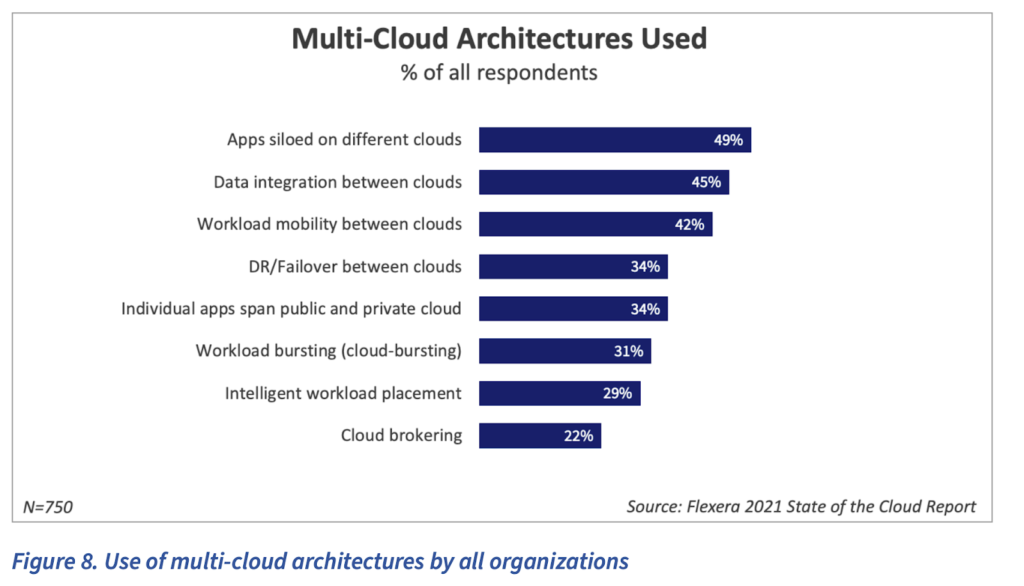
Who’s On Top?
AWS is still dominant, but others are catching up. According to the Hashicorp report, AWS still has pole position in terms of current and planned usage, which isn’t exactly surprising because of the sheer size of AWS revenues (annualized run rate of $71B) and 40% growth rate as of Amazon’s Q4 2021 earnings. Even looking forward a couple of years, AWS maintains its position in buyer priorities, as seen in this graph from the Hashicorp report:
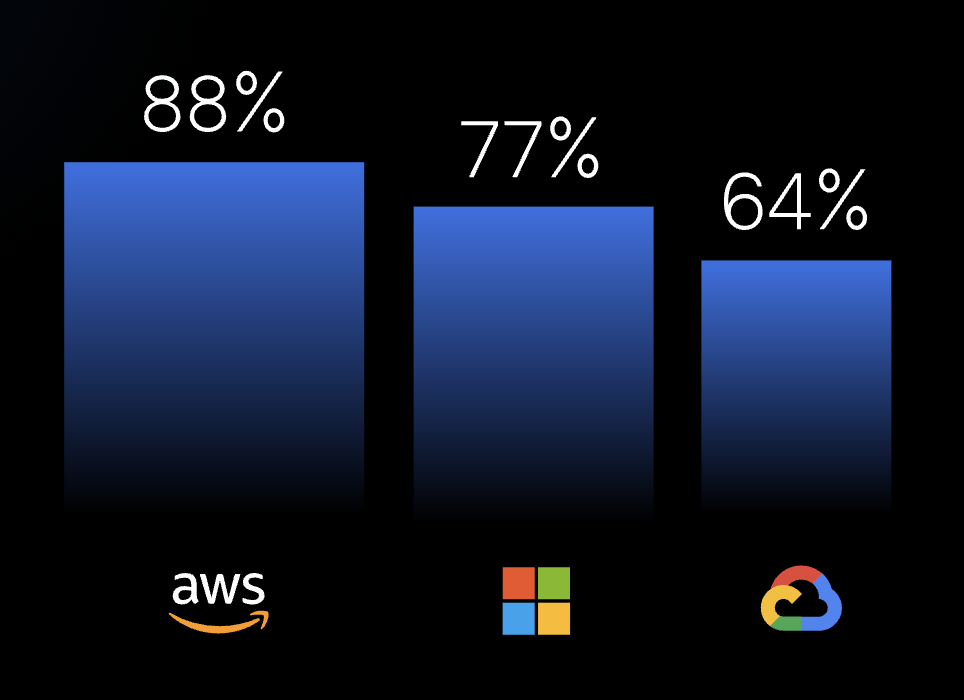
That said, the Flexera report found that Azure was catching up to AWS in terms of adoption rates across all organizations and enterprise-class organizations in particular. Figure 50 (seen below) from the Flexera report shows that among enterprises, Azure is nearly tied with AWS for breadth of adoption within enterprises. The graph shows distribution of adoption from being in planning mode to running significant workloads.
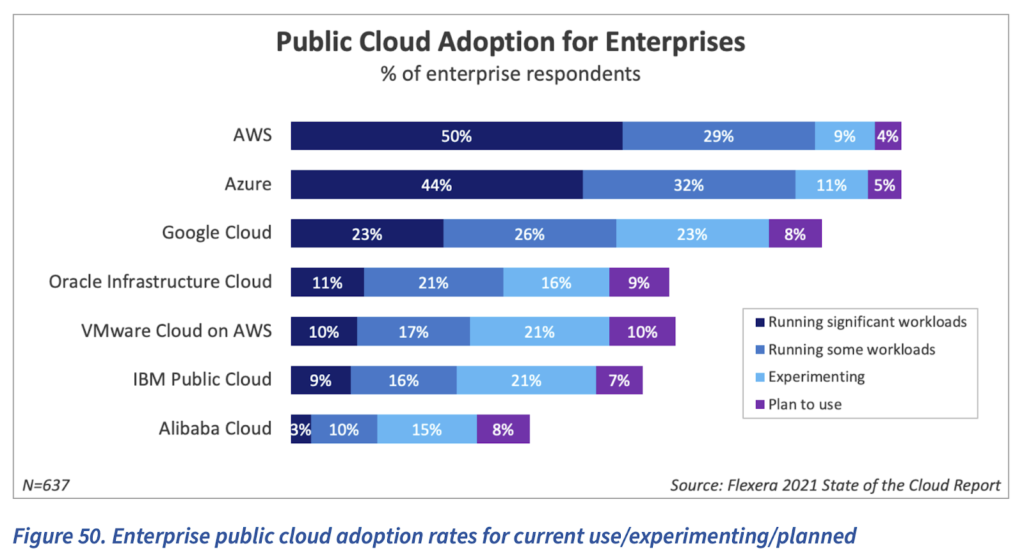
No Slowdown in Cloud Growth
Respondents to the Flexera survey shared they’re running 50% of their workloads in public cloud and they expect that to increase to 57% in the next twelve months, which is astounding. Further, 46% of their data is in the public cloud today, with plans to increase to 54% in the next year.
In terms of top cloud initiatives, despite the fact that the Flexera report is oriented to draw out cloud management priorities, many of the top priorities have to do with growing cloud presence. For example:
Agility is Still the Key Driver in Cloud
Hashicorp’s survey asked about the business and technology factors driving multi-cloud adoption, offering cost reduction, scaling, avoiding lock-in, and digital transformation as options. The weighting of responses (as seen below) towards digital transformation and avoiding lock-in indicate business agility is a key priority.
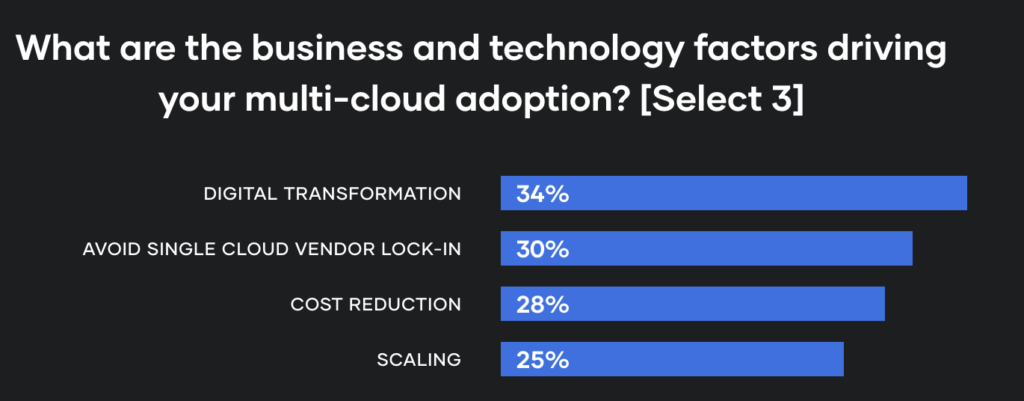
For enterprise-class organizations, digital transformation was an even bigger factor at 50% weighting in responses to the same question above.
The whole point of cloud is agility to consume infrastructure, services, and applications in a fashion that meets rapidly changing business needs.
Perspective: Don’t Forget Agile Cloud Connectivity
Cloud computing has achieved mainstream status, and organizations are now maturing their architectures by moving to multi-cloud to press deeper into the business agility advantages of the cloud. Yet without sufficiently agile hybrid and multi-cloud connectivity, you can’t fully realize cloud’s promise. Cloud workload and data migration, cloud backup and disaster recovery, distributed application architectures and related data pipelines all require sufficient network capacity and predictable latency to deliver performance to users and business processes.
Traditional telco approaches are the antithesis of cloud agility, making you wait weeks and months. Fortunately, Network-as-a-Service offers the scape, speed, and flexibility needed to maximize the effectiveness and efficiency of maturing cloud architectures. That’s why Gartner’s Private Cloud Connectivity Services report from July 2021 projected that software-defined cloud connectivity will grow from less than 10% of enterprises to 30% between 2020 and 2024.
If you’re ready to learn more about Network-as-a-Service, explore our services overview. If you’d like to get some guidance on how to modernize your cloud connectivity, request a demo. Or, if you’re more of a do-it-yourself type, you can get moving today with our self-service portal.